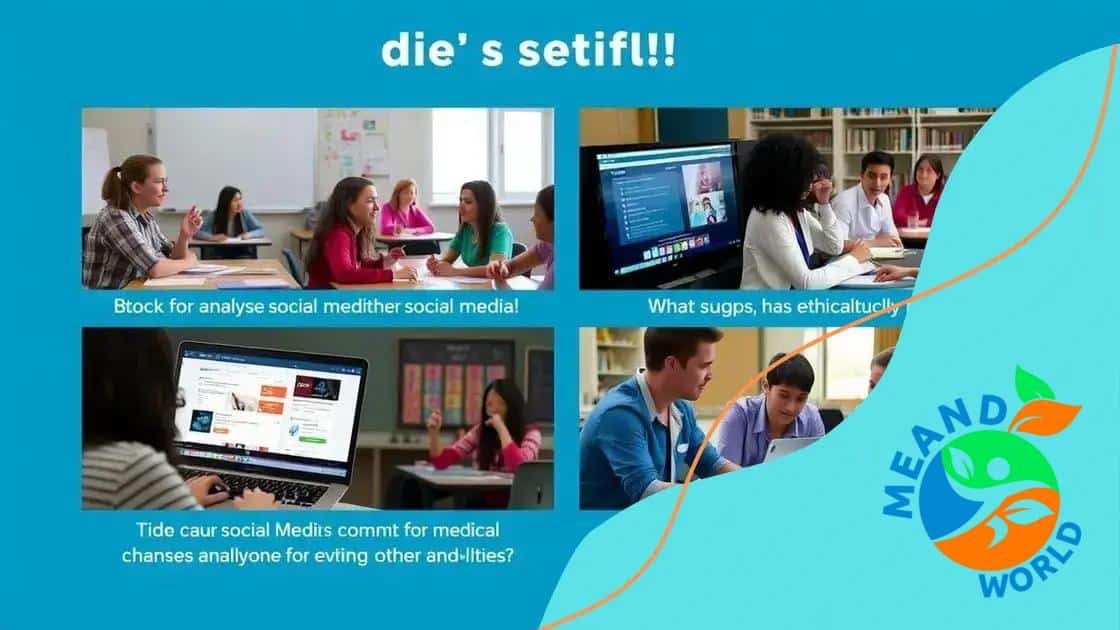The role of digital ethics in school curricula

Anúncios
The role of digital ethics in school curricula is essential for teaching students responsible online behavior, protecting their privacy, and understanding the ethical implications of technology use.
The role of digital ethics in school curricula is becoming increasingly important in today’s technology-driven society. Have you ever wondered how ethical considerations impact the digital world we live in? Let’s dive into this crucial topic.
Anúncios
Understanding digital ethics and its importance
Understanding digital ethics and its importance is crucial in our rapidly evolving digital age. As technology permeates our daily lives, ethical considerations regarding its use are becoming paramount. Digital ethics involves the critical examination of how technology impacts individuals and society, as well as the moral principles guiding these interactions.
Anúncios
Why Digital Ethics Matters
When we think about technology, we often focus on its benefits, such as improved communication and access to information. However, it is vital to recognize the ethical dilemmas that arise, such as privacy concerns and misinformation.
- Privacy: How data collection impacts individual rights.
- Misinformation: The spread of false information online and its implications.
- Digital Footprint: Understanding how online actions leave permanent traces.
- Cybersecurity: The need to protect sensitive information from cyber threats.
As we navigate these challenges, it becomes increasingly important to educate students about the principles of digital ethics. This knowledge empowers them to make informed decisions and participate responsibly in the digital world. Educators play a key role in integrating digital ethics into school curricula, ensuring students understand the consequences of their online actions and the importance of ethical behavior.
Additionally, teaching digital ethics can lead to a more critical approach among students when engaging with technology. By encouraging discussions about ethical dilemmas and real-world scenarios, students can develop their critical thinking skills. This prepares them for the challenges of tomorrow’s digital landscape.
Ultimately, fostering a comprehensive understanding of digital ethics in education is not just about ruling out bad behavior online; it’s about cultivating a generation that values integrity, responsibility, and empathy in their digital interactions.
Integrating digital ethics into lesson plans
Integrating digital ethics into lesson plans is vital for creating informed future leaders. These lessons help students understand their responsibilities in a digital world, promoting critical thinking. A practical approach involves weaving ethical discussions into existing subjects, making the content relevant and engaging.
Steps for Integration
When teachers consider how to incorporate digital ethics into their plans, they can take several practical steps. First, they should identify key topics within their curriculum where ethical discussions naturally fit. For instance, in a science class discussing technology, introducing topics on data privacy can be effective.
- Identify ethical dilemmas related to the subject matter.
- Use current events to spark discussions on digital ethics.
- Encourage group projects that focus on ethical solutions.
- Create assignments that challenge students to think critically about technology.
Teachers can also utilize real-world scenarios that highlight ethical issues in technology, such as social media’s role in modern communication. Students can explore questions like, “What are the consequences of oversharing online?” These discussions can lead to a better understanding of their digital footprint.
Classroom activities that promote role-playing or debating ethical scenarios can also enhance engagement. For example, students might simulate a tech company making decisions on data ethics.
By integrating digital ethics into lesson plans, teachers can foster a culture of responsibility and awareness. Engaging students in thoughtful discussion and critical thinking about their digital actions can lead to more ethical behavior in the long run.
Case studies of digital ethics in education

Case studies of digital ethics in education provide valuable insights into how schools tackle ethical dilemmas related to technology. These real-world examples help illustrate the importance of teaching digital ethics and highlight the positive outcomes that can arise when they are effectively integrated into curricula.
Real-World Examples
One notable case involved a high school that implemented a program exploring social media’s impact on students. During this program, students analyzed various posts for implications on privacy and digital citizenship. This hands-on approach allowed them to see the consequences of their online actions firsthand.
Another example comes from a middle school that faced issues with cyberbullying. The school organized workshops to educate students about respectful online behavior and the significance of empathy in digital communication. These workshops included role-playing to help students understand the effects of their words and actions.
- The impact of social media on student well-being.
- How schools address cyberbullying through education.
- Programs that foster respectful online communication.
- Incorporating discussions on data privacy related to student information.
Additionally, a university developed a class focused on ethical decision-making in technology use. Students were given real scenarios involving ethical dilemmas, prompting discussions and debates about the best practices. This interactive learning environment helped students think critically about digital ethics and the implications of technology in society.
These case studies showcase the necessity of integrating digital ethics into education. By examining real-life examples, students can better understand the relevance of their actions in the digital realm. Schools that actively engage in teaching digital ethics equip students with the skills needed for responsible navigation of the digital landscape.
Challenges in teaching digital ethics
Teaching digital ethics comes with various challenges that educators must navigate. One major hurdle is the rapidly changing landscape of technology. As new platforms and tools emerge, keeping up with their ethical implications can be daunting for teachers.
Addressing Various Levels of Understanding
Another challenge lies in the varying levels of understanding among students. Not all students have the same background knowledge about technology or ethics. Educators must design lessons that are accessible to everyone, from tech-savvy students to those who may be less familiar with digital platforms.
- Recognizing different proficiency levels in students.
- Creating inclusive lessons that engage all learners.
- Providing real-life examples for practical understanding.
- Encouraging open discussions about experiences with technology.
Additionally, some students may feel resistant to discussing digital ethics. Topics like privacy and online behavior can provoke strong opinions or discomfort. Teachers need to foster a safe classroom environment where students feel comfortable sharing their thoughts and experiences without fear of judgment.
Another obstacle is the lack of training for educators themselves. Many teachers may not feel confident in teaching digital ethics if they lack a solid understanding of the subject. Continuous professional development is vital, equipping teachers with the necessary knowledge and resources to tackle these complex topics.
Lastly, integrating digital ethics into existing curricula can be challenging. Teachers often face pressure to cover a specific syllabus and may struggle to find time for ethical discussions. However, weaving ethical considerations into lessons can enrich student learning and engagement.
Future trends in digital ethics education
Future trends in digital ethics education are set to transform how students learn about their roles in a technology-driven society. As technology evolves, so do the challenges and ethical questions that arise. Educators are adapting their approaches to keep pace with these changes and to prepare students for the future.
Emphasis on Interdisciplinary Approaches
One emerging trend is the push for interdisciplinary approaches in teaching digital ethics. Combining subjects like computer science, social studies, and art can provide a more holistic understanding of ethical issues. This strategy encourages students to see the connections between technology and its impacts on various aspects of life.
- Integration of topics like data security in science classes.
- Discussions about the societal impact of technology in history lessons.
- Creative projects that explore moral dilemmas in digital art.
- Group discussions that combine perspectives from different disciplines.
Another important trend is the increased use of technology itself as a teaching tool. Virtual reality (VR) and augmented reality (AR) can create immersive learning experiences. For instance, students could explore the consequences of their online actions in a simulated environment, providing powerful insights into digital ethics.
Moreover, there is a growing need for curriculum developers to include concepts of data privacy and cybersecurity. As students become more dependent on technology, knowing how to protect their personal information is crucial. Schools that highlight these skills prepare students for responsible technology use in their personal and professional lives.
In addition, the role of parents and community members is becoming more significant in digital ethics education. Schools are increasingly involving families in discussions about ethical technology use, fostering a community approach to solving ethical dilemmas. Workshops and seminars can empower parents to address these topics at home.
As we look toward the future, it is clear that digital ethics education will continue to evolve. The integration of technology, interdisciplinary lessons, and community involvement will play pivotal roles in shaping how students understand and engage with the ethical challenges of the digital age.
In conclusion, the integration of digital ethics into education is essential for preparing students for a technology-driven future. By addressing challenges, embracing future trends, and fostering open discussions, educators can create a positive impact on young minds. This knowledge is not only vital for personal responsibility but also helps build a more ethical society overall. As technology continues to evolve, the importance of digital ethics in the classroom will only grow, equipping students with the skills they need for responsible online behavior.
FAQ – Frequently Asked Questions about Digital Ethics in Education
Why is digital ethics important for students?
Digital ethics is crucial for students as it helps them understand responsible online behavior and the consequences of their digital actions.
How can teachers integrate digital ethics into their curriculum?
Teachers can incorporate digital ethics by using real-world scenarios, interdisciplinary approaches, and interactive discussions to engage students.
What challenges do educators face when teaching digital ethics?
Educators often struggle with keeping up with rapidly changing technology, varying student proficiency levels, and fostering open discussions about sensitive topics.
What are future trends in digital ethics education?
Future trends include increased use of technology in teaching, interdisciplinary learning approaches, and community involvement in ethical discussions.





